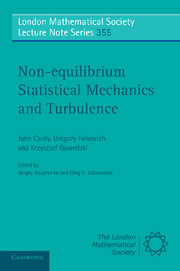Preface
Published online by Cambridge University Press: 05 June 2012
Summary
Understanding of turbulence is one of the most challenging problems of modern mathematical and theoretical physics. Turbulence can be described as a chaotic, highly non-equilibrium state of a non-linear physical system. Defined this way, turbulence embraces a broader class of examples than the chaotic Navier-Stokes flow, – a system for which the concept of turbulence was originally introduced and developed. In particular, turbulence appears as far-from-equilibrium states in plasmas, solids, Bose-Einstein condensates and even in nonlinear optics. The characteristic feature of turbulence is the presence of significant energy exchange between many degrees of freedom, which renders most attempts of perturbative treatment of the problem useless. Still mathematicians, physicists and engineers invest a large effort in understanding of turbulence due to the unprecedented importance of turbulence both for theoretical and applied science.
Thanks to fundamental works of Richardson, Taylor, Kolmogorov and Obukhov, we have a phenomenology of turbulent cascades leading to the famous Kolmogorov spectrum. This theory has been successfully applied to a wide range of turbulent systems. What is still lacking, however, is a fundamental theory of turbulence, which would allow both finding a rigorous mathematical foundation for the Kolmogorov theory and understanding of its limitations.
- Type
- Chapter
- Information
- Non-equilibrium Statistical Mechanics and Turbulence , pp. ix - xPublisher: Cambridge University PressPrint publication year: 2008



